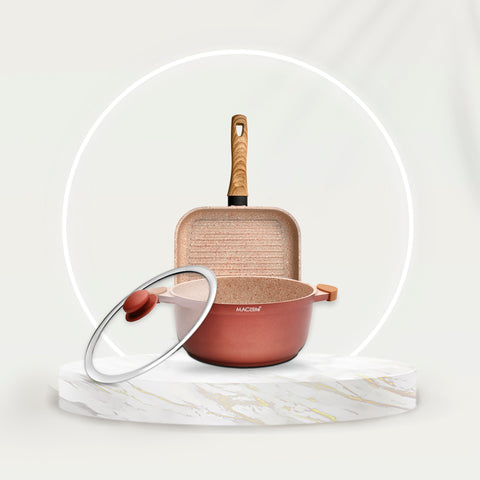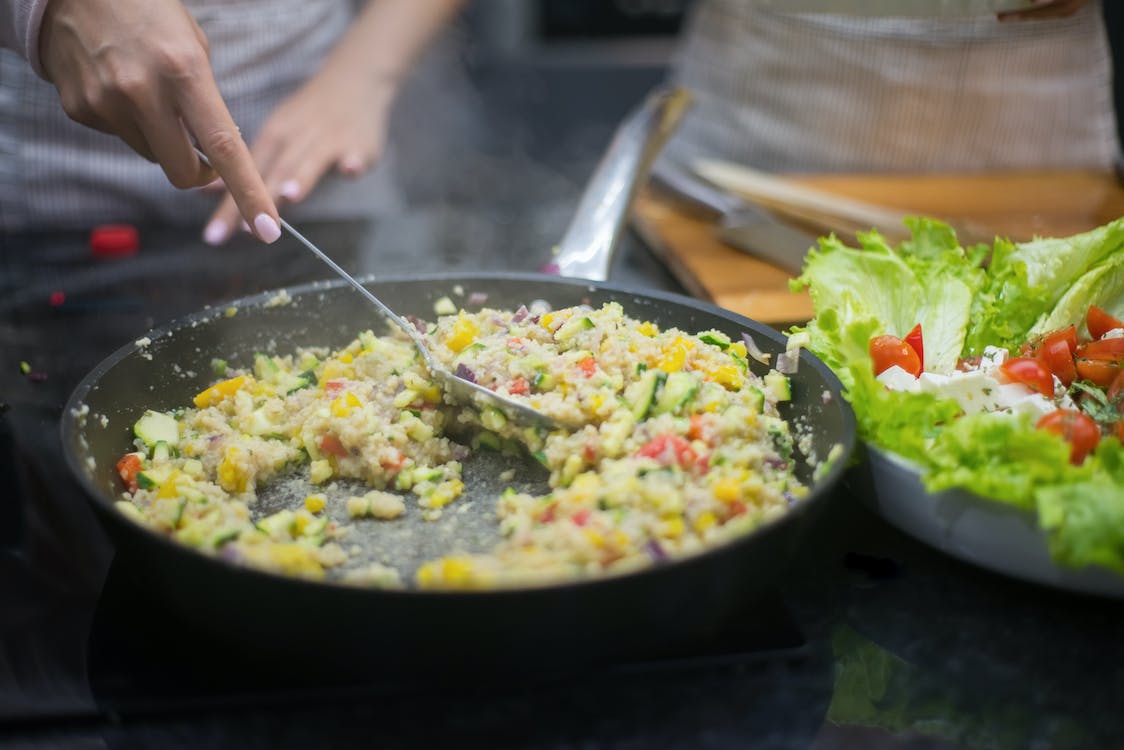
A Guide to Materials, Performance, Maintenance, Health, & Smart Buying Decisions
Welcome to "Mastering Cookware: A Comprehensive Guide to Materials, Performance, Maintenance, Health, and Smart Buying Decisions." Cooking is an art that can be greatly enhanced by the right tools, and one of the essential elements in any kitchen arsenal is quality cookware. From the material it's made of to its performance, maintenance requirements, health considerations, and making the right purchasing decisions, there's a lot to explore when it comes to cookware.
In this comprehensive guide, we will delve into the world of cookware, equipping you with the knowledge you need to make informed choices and elevate your culinary endeavours. We will take a close look at various cookware materials and how they impact cooking performance. Whether it's cast iron, nonstick, copper, or other materials, understanding their characteristics will empower you to select the best option for your cooking style.
Beyond performance, we will also explore the importance of proper maintenance to ensure the longevity of your cookware investment. From cleaning techniques to storage tips, you'll discover how to keep your cookware in pristine condition and maximize its lifespan.
Moreover, we cannot overlook the crucial aspect of health considerations associated with cookware. We will address any potential health risks associated with certain materials and coatings, providing you with the information needed to make health-conscious decisions in your kitchen.
Finally, we will guide you through the process of smart buying decisions. With so many options available, choosing the right cookware set can be overwhelming. We will discuss key factors to consider, including functionality, budget, and compatibility with different stovetops.
Whether you're a seasoned chef or a beginner in the kitchen, this guide aims to empower you with the knowledge and insights to become a master of cookware. Get ready to elevate your cooking experience as we embark on this journey of discovering the world of cookware materials, performance, maintenance, health considerations, and smart purchasing decisions. Let's dive in!
By addressing these questions, we can provide information and guidance is required make the content with useful insights into cookware materials, performance, maintenance, health considerations, and purchasing decisions.
- What are the different types of cookware materials available, and how do they affect cooking performance?
- Which cookware material provides the best heat conductivity and even heat distribution for precise cooking?
- What are the pros and cons of nonstick cookware, and are there any health concerns associated with its use?
- How do I properly clean and maintain different types of cookware to ensure their longevity?
- What factors should I consider when selecting the right cookware set for my kitchen, taking into account both functionality and budget?
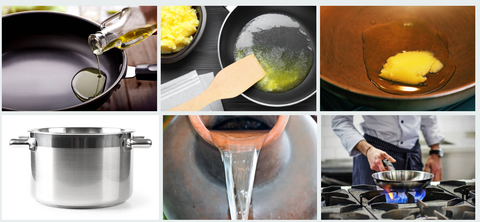
What are the different types of cookware materials available, and how do they affect cooking performance?
Cookware materials play a significant role in cooking performance, and understanding their characteristics can help you make informed choices in the kitchen. Here, we'll explore the various types of cookware materials and how they impact your cooking experience.
Stainless Steel: Stainless steel is a popular choice due to its durability, resistance to corrosion, and non-reactive nature. It offers even heat distribution, making it suitable for a wide range of cooking techniques. However, stainless steel alone is not a great conductor of heat, so many stainless steel cookware sets feature an aluminum or copper core for improved heat conductivity.
Nonstick: Nonstick cookware is known for its easy food release properties, making it ideal for low-fat cooking and delicate ingredients. It usually features a coating, such as Teflon, that prevents food from sticking. Nonstick cookware requires less oil for cooking, but it should be used with non-metal utensils to avoid damaging the coating.
Cast Iron: Cast iron cookware is renowned for its excellent heat retention and even heat distribution. It is ideal for searing, frying, and slow cooking. Although it requires regular seasoning and maintenance to prevent rust, properly cared for cast iron cookware can last a lifetime.
Copper: Copper offers exceptional heat conductivity, allowing for precise temperature control. It heats up quickly and evenly, making it ideal for tasks that require rapid adjustments in heat. However, pure copper cookware can react with acidic foods, so most copper cookware has a lining, such as stainless steel, to prevent this.
Aluminum: Aluminum cookware is lightweight, affordable, and conducts heat well. It heats up quickly, but it may cause some foods to react and develop a metallic taste. To mitigate this, many aluminum cookware pieces are now coated or anodized to prevent food contact with the raw metal.
Ceramic: Ceramic cookware features a nonstick coating made from natural materials. It is known for its attractive designs and even heat distribution. However, it may be prone to chipping or scratching over time and requires gentle care to maintain its longevity.
Each cookware material has its advantages and considerations. When choosing the right cookware for your needs, consider factors such as heat conductivity, durability, reactivity with certain foods, and maintenance requirements. By understanding the different materials and their impact on cooking performance, you can select the cookware that suits your culinary preferences and enhances your overall cooking experience.
Which cookware material provides the best heat conductivity and even heat distribution for precise cooking?
When it comes to heat conductivity and even heat distribution, copper cookware stands out as one of the best materials available. Copper is an excellent conductor of heat, meaning it quickly and efficiently transfers heat across the entire surface of the cookware. This property allows for precise temperature control, making it ideal for tasks that require rapid adjustments in heat levels.
The outstanding heat conductivity of copper ensures that there are no hot spots or cold spots on the cooking surface, providing even heat distribution. This feature is particularly beneficial for delicate dishes that require precise and uniform cooking.
However, it's worth noting that pure copper cookware can react with certain acidic foods, which may result in a metallic taste and discoloration. To mitigate this, many copper cookware sets have a lining made of stainless steel or another non-reactive material, which preserves the heat conductivity of copper while preventing any adverse reactions with food.
What are the pros and cons of nonstick cookware, and are there any health concerns associated with its use?
Nonstick cookware is widely popular for its convenience and ease of use. However, it's important to consider both the pros and cons before making a decision. Let's explore the advantages and disadvantages of nonstick cookware, as well as any potential health concerns associated with its use.
Pros of Nonstick Cookware:
Easy Food Release: The primary benefit of nonstick cookware is its ability to prevent food from sticking to the surface. This feature makes cooking and cleaning a breeze, requiring less oil or fat for cooking and reducing the likelihood of food burning or sticking to the pan.
Healthier Cooking: With nonstick cookware, you can minimize the amount of oil or fat needed in your recipes, promoting healthier cooking options. It's particularly useful for low-fat cooking and recipes that involve delicate ingredients like fish or eggs.
Quick Cleanup: Nonstick surfaces are easy to clean due to their food-repellent properties. Most food residues can be wiped off effortlessly, requiring less scrubbing and reducing the time spent on cleanup.
Cons of Nonstick Cookware:
Fragile Coating: The nonstick coating on cookware can be susceptible to scratching, especially when using metal utensils or abrasive cleaning tools. Once the coating is damaged, it may lose its nonstick properties and potentially release harmful substances.
Limited High-Heat Use: Nonstick cookware is not suitable for high-heat cooking methods such as searing or broiling, as excessive heat can damage the coating. This limitation may restrict the versatility of nonstick pans for certain cooking techniques.
Health Concerns:
The health concerns associated with nonstick cookware are primarily related to the potential release of perfluorooctanoic acid (PFOA) and other chemicals when the coating is heated to high temperatures. PFOA has been phased out in the manufacturing of nonstick coatings, but there is still some debate regarding the long-term effects of its replacement chemicals.
To minimize potential health risks, it is recommended to use nonstick cookware on low to medium heat settings and avoid overheating. Additionally, avoid using metal utensils or abrasive cleaning materials that can damage the coating and potentially release harmful substances.
In recent years, there has been an increase in the availability of ceramic-based nonstick coatings, which are considered safer alternatives to traditional nonstick coatings. These ceramic coatings are typically made from natural materials and are free from PFOA and other potentially harmful chemicals.
In conclusion, nonstick cookware offers convenience and easier cooking experiences. However, it's important to handle nonstick cookware with care, avoid overheating, and use non-metal utensils to maintain the integrity of the coating and minimize any potential health concerns associated with its use. Consider opting for ceramic-based nonstick cookware for a safer alternative if you have concerns about traditional nonstick coatings.
How do I properly clean and maintain different types of cookware to ensure their longevity?
Proper cleaning and maintenance are essential for preserving the longevity of your cookware. Different types of cookware require specific care to keep them in optimal condition. Here are some general tips for cleaning and maintaining different types of cookware:
Stainless Steel Cookware
- After each use, allow the cookware to cool down before cleaning.
- Wash stainless steel cookware with warm soapy water and a non-abrasive sponge or cloth.
- For stubborn food residues, soak the cookware in warm soapy water before cleaning.
- Avoid using abrasive cleaners or steel wool, as they can scratch the surface.
- To maintain the shine, you can periodically polish stainless steel cookware with a stainless steel cleaner.
Nonstick Cookware
- Clean nonstick cookware after each use, once it has cooled down.
- Hand wash with warm soapy water using a soft sponge or cloth.
- Avoid using abrasive cleaners, scouring pads, or metal utensils that can scratch the nonstick coating.
- If food is stuck, soak the cookware in warm soapy water to loosen it before cleaning.
- To protect the nonstick coating, store nonstick cookware with a soft cloth or paper towel placed between each piece.
Cast Iron Cookware
- Avoid using soap to clean cast iron, as it can remove the seasoning.
- After each use, rinse the cookware with hot water and use a brush or non-abrasive sponge to remove any food residues.
- If necessary, scrub with coarse salt or a small amount of mild detergent.
- Dry the cookware thoroughly to prevent rusting.
- To maintain the seasoning and prevent rust, periodically season cast iron cookware by applying a thin layer of oil and heating it.
Copper Cookware
- Clean copper cookware by hand using a copper cleaner or a mixture of vinegar and salt. Gently scrub with a soft sponge or cloth to remove tarnish or discoloration.
- Rinse with warm water and dry thoroughly to prevent water spots.
- To maintain the shine, periodically polish copper cookware with a copper cleaner or a mixture of lemon juice and salt.
General Tips for All Cookware
- Avoid using high heat settings unnecessarily, as it can damage the cookware.
- Don't use metal utensils on nonstick or delicate surfaces; opt for wooden, silicone, or nylon utensils instead.
- Avoid stacking heavy or sharp-edged cookware to prevent scratching or damage.
- Follow the manufacturer's instructions for specific care recommendations.
By following these guidelines, you can ensure that your cookware remains in excellent condition and lasts for many years to come. Proper cleaning and maintenance will not only preserve the longevity of your cookware but also enhance its cooking performance.
What factors should I consider when selecting the right cookware set for my kitchen, taking into account both functionality and budget?
When selecting the right cookware set for your kitchen, it's important to consider various factors that balance functionality and budget. Here are some key factors to keep in mind:
Cooking Needs: Consider the type of cooking you do and the specific cookware pieces you require. Think about the size and variety of pots, pans, and specialized cookware (e.g., a Dutch oven, a wok, or a roasting pan) that will suit your cooking style and the dishes you frequently prepare.
Material: Choose cookware material based on your cooking preferences and needs. Consider factors such as heat conductivity, durability, reactivity with certain foods, and maintenance requirements. Common materials include stainless steel, nonstick, cast iron, copper, and aluminum. Each has its pros and cons, so assess which material aligns best with your cooking habits.
Heat Conductivity: Look for cookware that offers good heat conductivity and even heat distribution. This ensures that your food cooks evenly and prevents hot spots. Copper and aluminum are excellent heat conductors, while materials like stainless steel often have an aluminum or copper core to enhance heat distribution.
Durability: Consider the durability of the cookware. Opt for high-quality materials and reputable brands known for their durability. Cheaper options may save you money initially, but they may not last as long and may require more frequent replacement.
Maintenance: Assess the maintenance requirements of the cookware. Some materials, like nonstick or copper, may require specific care instructions to maintain their performance and longevity. Consider your willingness to follow these instructions and allocate time for maintenance.
Compatibility: Ensure that the cookware is compatible with your stovetop. Check if it is suitable for induction, gas, electric, or ceramic cooktops based on your kitchen setup.
Budget: Determine your budget range for the cookware set. Cookware prices can vary significantly, so decide on a budget that aligns with your financial considerations. Remember that investing in higher-quality cookware can often result in better long-term performance and durability.
Reviews and Recommendations: Read customer reviews and seek recommendations from trusted sources or friends who have experience with the cookware sets you're considering. Their insights can provide valuable information and help you make an informed decision.
By considering these factors, you can select a cookware set that meets your functional needs, fits within your budget, and enhances your overall cooking experience. Remember to strike a balance between functionality, quality, and affordability to make a well-informed decision.
MACclite Aluminium Frying Pan

 Save 50%
Save 50% MACclite Aluminium Non-Stick Alpha Frying Pan 20cm Dia/1.25 Liters.
MACcliteBrand: MACclite Material: Aluminium Series: Alpha Product Dia: 20 Centimeter Capacity: 1.25 Liter Colour: Assorted Colour Gas Stove Compatible ...
View full details
 Save 50%
Save 50% MACclite Aluminium Non-Stick Alpha Frying Pan 24cm Dia/1.7 Liters.
MACcliteBrand: MACclite Material: Aluminium Series: Alpha Product Dia: 24 Centimeter Capacity: 1.7 Liter Colour: Assorted Colour Gas Stove Compatible On...
View full details

MACclite Aluminium Die Cast Non-Stick Granite + Induction Base Butter Scotch Frying Pan 24cm Dia/2 Liters.
MACcliteBrand: MACclite Material: Aluminium Dia Cast Series: Granite (Butter Scotch) Product Dia: 24 Centimeter Capacity: 2 Liters Color: Butte...
View full detailsFeatured collection
-
Original price - Original priceOriginal price Rs. 19.99Rs. 19.99-Current price Rs. 19.99
Product title
Original price - Original priceOriginal price Rs. 19.99Rs. 19.99-Current price Rs. 19.99 -
Original price - Original priceOriginal price Rs. 19.99Rs. 19.99-Current price Rs. 19.99
Product title
Original price - Original priceOriginal price Rs. 19.99Rs. 19.99-Current price Rs. 19.99 -
Original price - Original priceOriginal price Rs. 19.99Rs. 19.99-Current price Rs. 19.99
Product title
Original price - Original priceOriginal price Rs. 19.99Rs. 19.99-Current price Rs. 19.99 -
Original price - Original priceOriginal price Rs. 19.99Rs. 19.99-Current price Rs. 19.99
Product title
Original price - Original priceOriginal price Rs. 19.99Rs. 19.99-Current price Rs. 19.99 -
Original price - Original priceOriginal price Rs. 19.99Rs. 19.99-Current price Rs. 19.99
Product title
Original price - Original priceOriginal price Rs. 19.99Rs. 19.99-Current price Rs. 19.99
Blog posts
-
-
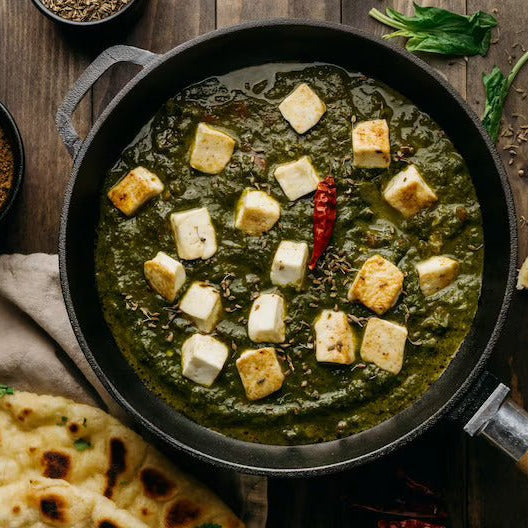
What is Karahi or Kadahi? Exploring Its Best Use in 2024 | Non Stick
The kadai or karahi holds a special place, when it comes to Indian cooking,choose MACclite kadai cookware for a healthier and more enjoyable cooking experience.Read now -
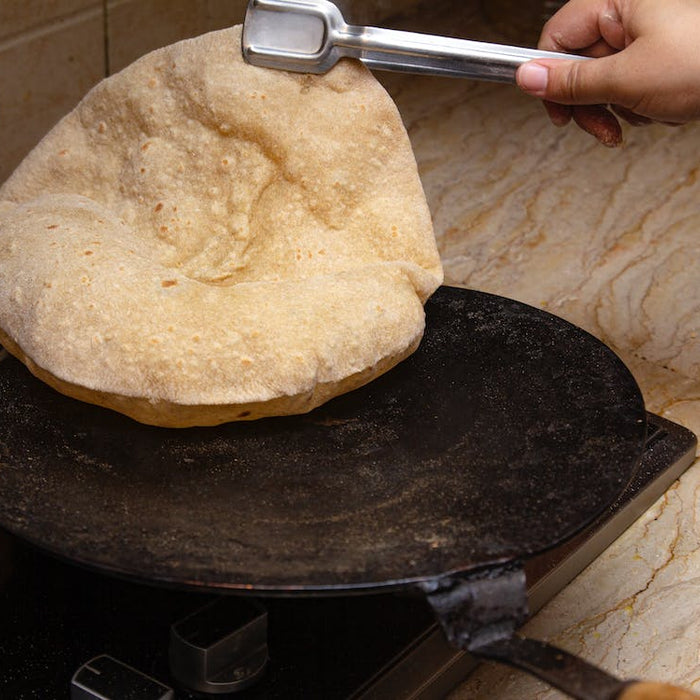
Best Tawa for Roti 2024 - Guide to Choosing the Best Iron Tawa for Your Family
The roti tawa is the right tool to achieve the ideal texture and taste. Finding the perfect roti tawa for your family can be both rewarding and challenging in 2024 due to the many options available.Read now



